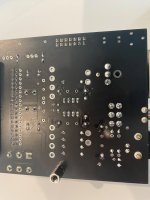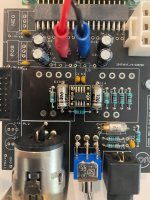Hi!
Maybe a resistor to ground would be enough?
You could try a 10kohm resistor to gnd just to check. (I suppose you pre-amp handles 10kohm).
Maybe a resistor to ground would be enough?
You could try a 10kohm resistor to gnd just to check. (I suppose you pre-amp handles 10kohm).
Well it seems the new Sparkos 2590 opamps are the problem. I think anyway. They are sending out up to 350 mV of DS offset. I put the stock 1612 dual opamps back in and one channel had only .6mV of DC and the other 50 mV of DC with the inputs open. 50 mV is still too high. The DC offset measurements change with opamp used. Switching the opamp from right to left channel input board showed the DC offset value always followed the particular opamp used! These opamps really seem to vary DC offset figures! Still scratching my head.
Send the Sparkos opamps back and cut your losses. The NC-500OEM modules won't trip their DC protect until 9-12V which is well into dangerous for connected woofers. The early Nord NC-500OEM based amps had no DC protection of their own- they rely on the module's protect.
These opamps really seem to vary DC offset figures! Still scratching my head.
Can you post the well-lit, in focus photos of that buffer board, top and bottom sides? Just remove the OPamps before you take the photos.
I really want to know the details on how these different opamps deliver varied DC offset numbers on this Rev D board made by Nord. Perhaps most all input/buffer boards in these Class D amps have these DC offset realities when opamp rolling?
The Sparkos SS2590 opamps do have a DC offset pot on the board to dial out DC offset. Here is what I did just now and the response from Sparkos regarding these opamps. Here is the note I sent to Sparkos.
Here is Sparkos response (Andrew). He has been very helpful. He said this 30-60mV is normal, safe, common and fine……….
“The reason for all of this is because our devices are BJT input, and so their inputs draw a small bias current that drops across input resistors and things like that and manifest as a DC offset.
The tiny offsets then get gained up by the rest of the circuit and can end up being 10s of MV at the speaker like you are seeing.
The other op amps are likely JFET input devices which have no DC current draw on their inputs. “
The Sparkos SS2590 opamps do have a DC offset pot on the board to dial out DC offset. Here is what I did just now and the response from Sparkos regarding these opamps. Here is the note I sent to Sparkos.
Can only zero out DC with the inputs shorted. With the inputs open DC offset just continues to ramp up to about 300 mA. With the inputs connected to my tube preamp, the DC offset as measured at the amps binding posts, start off at 130mV and slowly ramps down to zero and then slowly ramps up to about 30-60 mA over 30 minutes. One channel settles out at 35mV and the other at 55mV after 30 minutes +/- 5mV.
Measuring the DC output at my preamp that only measures 2.5 mV. My preamp is capacitor coupled at the output so that initial 130 mV dropping to zero is probably the time it takes for that cap to charge. What I don’t like is how the amp still ramps up to 30 to 60 mV over the next 30 minutes Keep in mind the standard 1612 OPAMPs did not do this at all. They stayed constant at right .3-.5mV.
There must be something about Your OPAMPS that just reacts differently to my preamp. Now my preamp output does not have a loading resistor to ground. I am wondering if a 100 K resistor to ground would solve/help this issue? Alos, why with your OPAMPS am I getting all of this fluctuation that just is not present with the standard OPAMPS? I’ve been switching back-and-forth between the standard ones and yours to verify this.
Here is Sparkos response (Andrew). He has been very helpful. He said this 30-60mV is normal, safe, common and fine……….
“The reason for all of this is because our devices are BJT input, and so their inputs draw a small bias current that drops across input resistors and things like that and manifest as a DC offset.
The tiny offsets then get gained up by the rest of the circuit and can end up being 10s of MV at the speaker like you are seeing.
The other op amps are likely JFET input devices which have no DC current draw on their inputs. “
Last edited:
Yes, it is important to use an appropriate OPAmp with the correct specifications. Another, equally important, ingredient is the PCB layout and the component values, hence why I asked for the photos.
I will load a photo! I remember I have an extra Rev D board. Nord suggests and approves the Sparkos opamp on his buffer boards. I see three small value film caps that I would love to replace with the right value Wima caps. The Nord owner would not share the values with me. I know the values of these stock caps, but Wima does not make values this small so he used a larger value.
Last edited:
I adjusted the Sparkos SS2950 OPAmp pots that dial out DC offset with my preamp connected. Now the DC offset does not go higher than 35mV. Sparkos confirmed all is as it should be. I also took to amp to a tech/designer and it measures very low noise and all is good. Pics of the Rev D buffer board without the Sparkos discrete voltage regulators or Opamps loaded.
Attachments
I was not aware the Sparkos had a DC offset trimpot. That makes it easy. I hate to say it, but if you had posted a few photos straight away, we would've noticed the little trim pot on that OPAmp. 🙂 This could have saved you a lot of time and headaches.
Here are some answers for you, from your earlier posts/questions:
The styrene caps are good; you will lose top-end sparkle if you replace them with polypropylene types. Don't do it
The buffer board looks good and is well constructed. It was purposefully built for that non-standard Sparkos OPAmp pin outline in mind.
In the future, in general, if you need great sound, minimal DC offset (input bias current less than 1 pA), and a standard package, go with OPA828 / OPA2828.
Nice, you got it sorted.
Here are some answers for you, from your earlier posts/questions:
The styrene caps are good; you will lose top-end sparkle if you replace them with polypropylene types. Don't do it
The buffer board looks good and is well constructed. It was purposefully built for that non-standard Sparkos OPAmp pin outline in mind.
In the future, in general, if you need great sound, minimal DC offset (input bias current less than 1 pA), and a standard package, go with OPA828 / OPA2828.
Nice, you got it sorted.
Last edited:
- Home
- Amplifiers
- Class D
- Measuring DC offset on A Hypex NC500 based Class D amp


